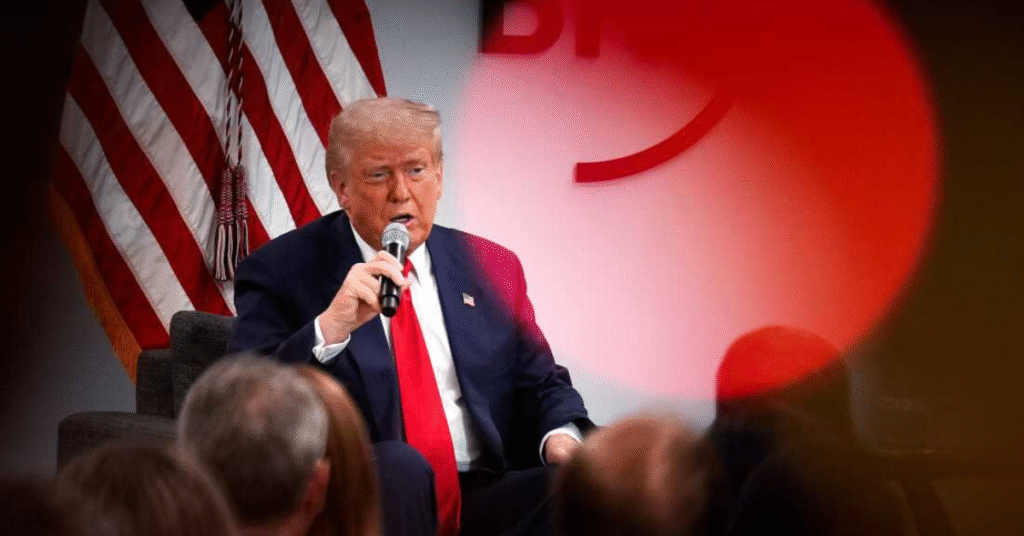The United States has entered the third day of a government shutdown, a political stalemate that is already beginning to ripple through federal operations, local communities, and the broader economy. The central drama driving the shutdown is President Donald Trump’s renewed threats of mass firings within federal agencies, should lawmakers fail to deliver a deal that meets his demands. While shutdowns are not unfamiliar in Washington, the intensity of rhetoric surrounding this impasse has heightened uncertainty across multiple sectors. Citizens are left questioning not only how long the shutdown will last but also what the practical consequences will be for essential services, workers’ paychecks, and the stability of public trust in institutions.
In these first 72 hours, the nation has witnessed agency closures, delayed federal payments, and public employees grappling with mounting financial stress. “It feels as if we are pawns in a political chess game,” one furloughed worker remarked. The live updates surrounding this moment capture the urgency of the political maneuvering, the social tension in affected households, and the looming risks if negotiations fail to break the deadlock soon. This article explores the current landscape of the shutdown in detail, explains its potential consequences, tracks the administration’s threats, and provides a grounded understanding of what is unfolding.
Understanding the Core of the Shutdown
At its heart, a government shutdown occurs when Congress fails to pass necessary appropriations bills or stopgap funding measures to keep the federal government running. In this case, partisan divides have grown sharper, as competing priorities clash over budget allocations and policy demands. President Trump’s insistence on tightening fiscal control and reshaping federal operations has escalated into threats of sweeping dismissals of federal employees. This aggressive posture has rattled unions, civil service advocates, and the general workforce, who fear not just temporary furloughs but permanent displacements.
Lawmakers are scrambling to negotiate while public attention remains fixed on Capitol Hill. The shutdown highlights long-standing structural issues in U.S. governance: deep ideological rifts, the weaponization of funding deadlines, and the human toll of political brinkmanship. Citizens now find themselves caught between abstract budgetary disputes and very real consequences—delays in Social Security claims, disruptions in immigration hearings, and uncertainty over food assistance programs.
Timeline of Events Leading to Day 3
To understand the present, it is necessary to trace the steps that led here. The shutdown did not emerge overnight but was instead the culmination of missed deadlines, collapsed negotiations, and high-stakes political messaging.
Table 1: Key Events Leading to Day 3 of the Shutdown
| Date | Event | Significance |
|---|---|---|
| Day -7 | Budget negotiations stall in Congress | Initial failure to reach compromise funding package |
| Day -3 | White House signals willingness to allow lapse in funding | Sets tone for potential shutdown |
| Day 0 | Midnight deadline missed | Official start of the government shutdown |
| Day 1 | Federal agencies announce furloughs | Thousands of workers affected |
| Day 2 | Trump threatens mass firings | Escalates political and social tension |
| Day 3 | Shutdown continues | Uncertainty deepens, negotiations ongoing |
This timeline reflects not only the breakdown in negotiations but also the deliberate use of brinkmanship. By Day 3, frustration is mounting among both policymakers and the public, as each passing hour without a resolution compounds the stakes.
The Human Impact: Workers and Families on Edge
For the hundreds of thousands of federal employees who face furloughs or delayed paychecks, the uncertainty is more than just financial—it is psychological. Stories are emerging of families struggling to cover rent, buy groceries, and manage healthcare costs while paychecks are stalled. Some workers are classified as “essential” and must continue working without pay, further heightening resentment. One employee at the Department of Transportation shared, “It’s not just about money; it’s about dignity. We’re expected to serve the nation, but we feel abandoned.”
Beyond employees, citizens depending on government services are experiencing direct effects. Passport applications are delayed, veterans’ benefits face interruptions, and small businesses awaiting federal loans are caught in limbo. The impact radiates outward, touching contractors, service providers, and even local economies near federal hubs. This lived experience of shutdown stress underscores the disconnect between political leaders and the day-to-day struggles of citizens.
Trump’s Threat of Mass Firings
The most controversial aspect of this shutdown has been Trump’s repeated suggestion that federal employees who are currently furloughed could face permanent job loss. While mass firings on such a scale are logistically and legally complex, the rhetoric itself has heightened tensions and created an atmosphere of fear. Labor unions have been vocal in denouncing the remarks, warning of the damage such threats could do to morale and long-term government functionality.
Observers note that Trump’s framing of the shutdown as a cost-cutting opportunity departs from past presidential strategies, which typically sought to minimize disruption and reassure employees. Instead, the focus on firings reflects a more combative political style. Analysts argue that such a stance could redefine how shutdowns are perceived, shifting them from temporary interruptions to potentially transformative crises with lasting effects on the workforce.
The Political Chessboard
At the heart of the shutdown lies a political struggle between the executive branch and Congress. Lawmakers are divided, with some advocating concessions to reopen the government quickly, while others insist on holding the line against Trump’s demands. The debate is not merely about funding but about precedent: if one side yields, it could shape the dynamics of future negotiations.
This shutdown reveals the fragility of bipartisan cooperation. Compromise appears elusive as lawmakers fear backlash from their respective political bases. The result is paralysis, with neither side able to claim victory without risking political costs. Citizens watching the spectacle are left to wonder whether political loyalty now outweighs the collective responsibility of governance. As one political scientist observed, “Shutdowns have become ritualized drama, but the stakes are very real for the people caught in the middle.”
Economic Consequences in the Making
Government shutdowns inevitably carry economic consequences, and this one is no exception. Each day of closure adds costs to the national economy through lost productivity, delayed contracts, and disruptions in regulatory oversight. Businesses relying on federal permits face slowdowns, airlines brace for staffing gaps in air traffic control, and markets grow uneasy with the uncertainty.
Table 2: Projected Economic Effects of Shutdown (First Week)
| Sector | Impact | Estimated Loss |
|---|---|---|
| Federal Workforce | Furloughs, delayed pay | $1.3 billion in wages stalled |
| Small Businesses | Delayed loans, stalled contracts | $500 million+ |
| Air Travel | Staffing shortages | Flight delays, potential $100 million loss |
| Tourism | National parks and monuments closed | $200 million in lost revenue |
| Markets | Investor uncertainty | Volatility in stock prices |
While shutdowns are often described as temporary, their aftershocks linger. A prolonged closure could erode consumer confidence, discourage investment, and create a drag on growth at a time when the economy is already navigating other global pressures.
Public Sentiment and National Trust
Beyond economics, the shutdown has implications for public trust in government institutions. Citizens are increasingly skeptical of leaders who appear more focused on political leverage than on service delivery. Social media is flooded with frustration, satire, and despair, reflecting a population weary of repeated political crises. A retired teacher in Michigan expressed it bluntly: “This isn’t leadership; this is hostage-taking with our livelihoods.”
Polls suggest growing impatience with Washington gridlock. Historically, blame in shutdowns has shifted between parties, but Trump’s threats of firings may uniquely position him as the central figure of criticism. Trust in government, already at historic lows, risks further decline, raising questions about the durability of democratic institutions when tested by repeated crises.
International Repercussions
Shutdowns in the U.S. rarely remain a purely domestic concern. Allies and rivals alike watch closely, interpreting dysfunction as a measure of America’s political stability. The sight of federal institutions grinding to a halt undermines confidence in the nation’s ability to lead on global issues. At the same time, adversaries exploit the narrative of disarray. Diplomats warn that prolonged shutdowns weaken negotiating positions, delay foreign aid, and limit defense coordination.
For global investors, the message is troubling. Stability in Washington has long been a pillar of international markets, and repeated shutdowns erode that perception. As one European economist observed, “Every shutdown is a reminder that America’s politics can be as volatile as its adversaries claim.”
Live Updates from Washington
As of Day 3, negotiations continue without a clear breakthrough. Lawmakers are scheduled for extended sessions, but partisan rhetoric remains sharp. Federal workers’ unions are organizing rallies, while advocacy groups call for citizen action. The White House maintains its hardline stance, and Trump has repeated his warnings on social media, further fueling anxieties.
Observers note that both sides face pressure to resolve the standoff before the weekend deepens public frustration. Yet the risk of further escalation looms, particularly if Trump escalates threats of permanent layoffs. The live updates underscore the precariousness of the situation, where each hour brings new statements, protests, and ripple effects across the nation.
FAQs
1. What caused the current government shutdown?
The shutdown was triggered by a budget impasse in Congress, with lawmakers unable to agree on funding measures. President Trump’s demands and threats of mass firings intensified the deadlock.
2. How are federal workers affected during the shutdown?
Many employees face furloughs or delayed paychecks, while essential workers continue duties without immediate compensation, creating financial strain.
3. Can President Trump legally fire large numbers of federal employees?
Mass firings on such a scale face significant legal and logistical barriers. However, the threats create fear and uncertainty among workers.
4. What are the economic impacts of the shutdown so far?
The economy is seeing stalled wages, business disruptions, and market volatility, with losses projected in the billions if prolonged.
5. How long could the shutdown last?
The duration depends on congressional negotiations. Shutdowns can last days or weeks, but escalating rhetoric complicates the path to compromise.
Conclusion
As the government shutdown enters its third day, the United States stands at a crossroads defined by political brinkmanship, economic uncertainty, and public frustration. The stalemate highlights systemic flaws in governance, where critical services and livelihoods are sacrificed to partisan disputes. Trump’s threats of mass firings have added a volatile element, raising anxieties among workers and shaping public perception of the administration’s approach.
Shutdowns are no longer rare disruptions but recurring crises, each leaving behind scars on trust, institutions, and stability. The live updates emerging from Washington provide a window into the fragility of compromise in an era of deep polarization. Yet the ultimate test remains: can leaders rise above partisanship to restore normalcy, or will citizens continue to bear the brunt of political theater?
As one veteran lawmaker observed, “Every shutdown is a failure of leadership. The question is how many more failures the nation can endure.”







